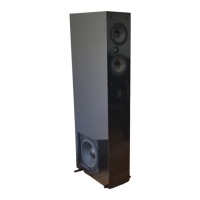To minimize noise
pickup,
segregate
cables by
function.
Do not run low leveJ signal cables
parallel
to
power
cables,
speaker cables. or dig;ta, cables. Also, do not run
speaker cables of digital cables
parallel
to
power
cords or
pa.allel
to
each other. lf different types of cables are
placed
near
each
other
at some
place
in
your
system, separate them by the
maximum
practical
distance and cross them at fight
angles
where
they meet. Do not twist or tie AC
power
cords with
speaker cables.
V
I Operation
The N4odel VT-2.4 was designed to handle a wide range of listening levels,
but
every speaker has
limits. lt is important to
use common sense and listen for signs of
possible
distress from the speakers. Underpowered
amplifiefs are most often
the cause of
speaker damage-
For
example, a 60-watt amplifief runs out of
power
when called upon to
produce
more
than
60 watts, and the resulting
distortion can damage the speaker lf
you
tend to listen at high volume levels, more
powerful
amplifiers are
preferable
because they
are less
likely
to run out of
power.
Noticeable distortion or harsh breakup is an indication that either
your
amplifier or
your
speakers are running
beyond
theif
capacity, and
the volume
should be decreased. lf
you
can feelany heat emanating fiom the woofer or tweeter, reduce the
{evel immediately. Speaker damage
most often occurs from sustained high volume levels, not from transient sounds or
brief musical
peaks.
Excessive
boosting of bass, treble or equalizer controls can
worsen
the
problem,
and is not
recommenoeo.
I Maintenance
Your speakers
require minimal maintenance
under normal use. The cabinet may be cleaned using a damp cloth or a mild,
non-abrasive cleaner To clean the
grille,
first remove
it from the speaker, then brush
lightly with
a soft brush of use a
vacuum on its lowest setting. Do not expose the speakers to direct sunlight, high temperatures, or moisture. Do not
attempt to clean the actual drivers.
v

